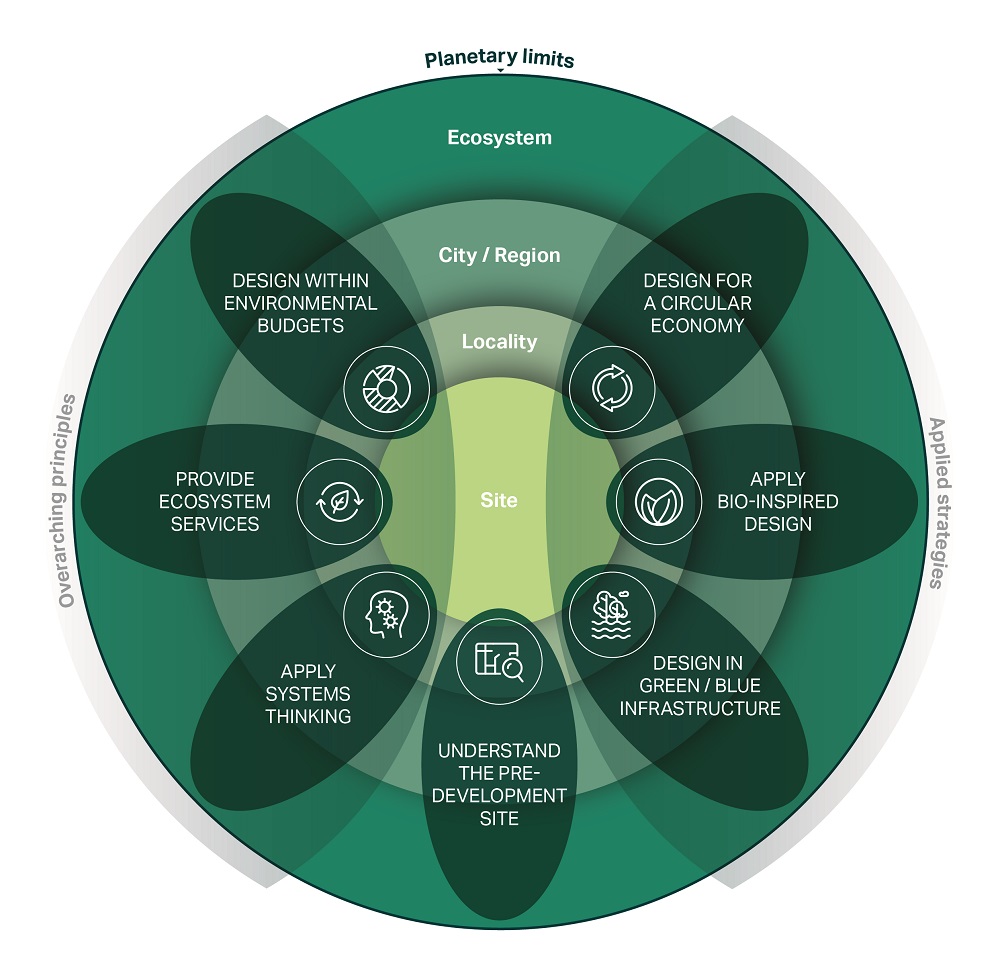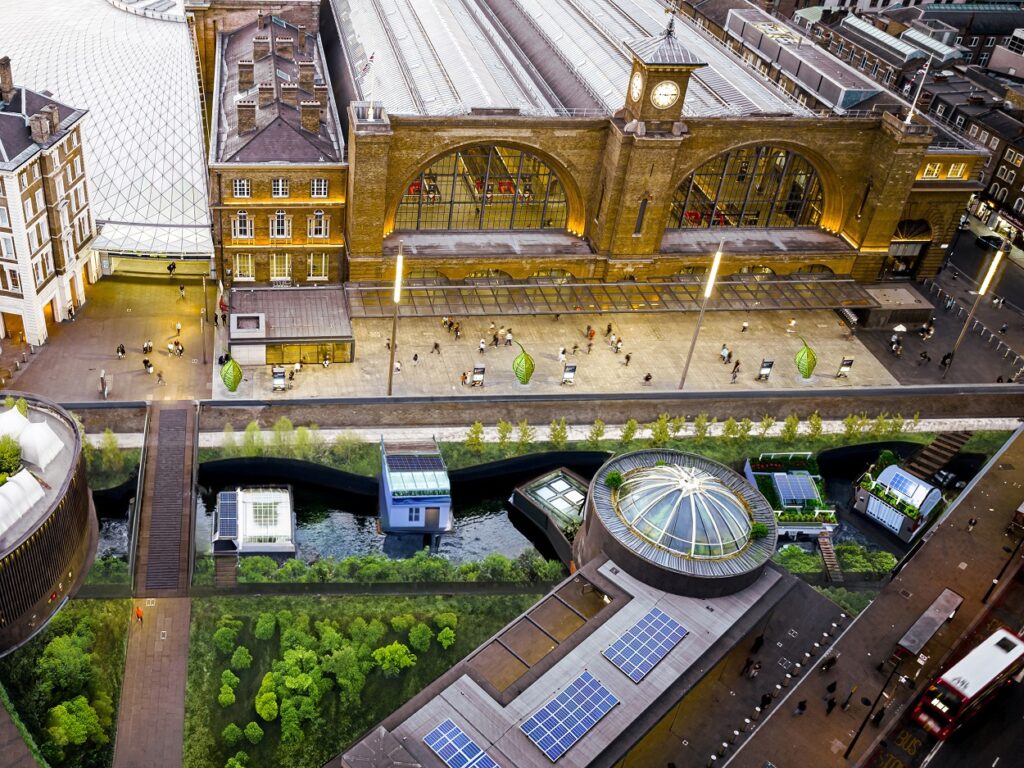Seven regenerative design principles to change our cities
Imagine a building that restores and regenerates natural systems and even metabolises like a living organism. No longer a wild daydream, the concept of regenerative design is starting to flourish in the face of the biodiversity crisis and climate change. Its application, however, requires a major shift in thinking.
In this article, sustainability expert David Cheshire presents seven revolutionary regenerative design principles to guide the way.
In our cities, isolated from nature and surrounded by steel, concrete, glass and tarmac, it is easy to forget that we are utterly dependent on natural systems for every breath of fresh air, sip of clean water and mouthful of food. The ecosystem is already in crisis and every building we construct further undermines the very mechanisms that allow us to survive.
Buildings and cities are currently a huge burden on the planet – as well the requiring land to build on, they cast a long shadow on our ecosystems, from the mining of resources, through to capturing and treating water, emptying sewage into our rivers and polluting pristine environments with ‘forever chemicals’.
We have been trying to reduce this harm by designing sustainable buildings which use less energy, water and materials, while generating less waste and pollutants. And this has been invaluable in raising awareness and starting the journey towards improving performance. However, this has only made the built environment less harmful and the climate and biodiversity crises are a stark reminder that this is no longer enough.
Instead, what if we could create buildings that have a positive impact on the planet? Ones that restore and regenerate natural systems and even metabolise like living organisms.
In this video, David Cheshire expands on the concept of regenerative design and what we can do to make buildings climate positive.
Imagine buildings that contribute energy and food, capture water, sequester carbon, clean the air, treat pollutants and reclaim nutrients from waste. All made from locally-available resources. Imagine local infrastructure that defends against flooding, is a haven for pollinators, reduces overheating and reconnects humans with nature.
It sounds like a wild daydream, but there are already examples of regenerative buildings that have become an active part of the ecosystem and there are even design approaches, such as the Living Building Challenge, that are encouraging and certifying schemes that are achieving this aim.
Regenerative design as a concept has been widely discussed, but it is much harder to tie it down to a set of design principles for buildings. Based on extensive research and interviews with designers that are already creating regenerative buildings, my new book – Regenerative by Design – proposes seven regenerative design principles and maps them onto the hierarchy of scale from the site through to the ecosystem, all bounded by the planetary limits (as shown in Figure 1).

The design principles (the seven dark green ellipses) straddle across all four of the concentric circles to demonstrate that the building and the site is intimately linked to the ecosystem, and that the wider context of each building has to be considered. The left-hand side of the diagram show the three overarching principles and the right-hand sides shows the three applied strategies for a project.
Regenerative design requires three major shifts in thinking (shown as the overarching principles in the diagram).
Firstly, recognising that there are absolute planetary limits in terms of the resources that can be used and the pollutants and waste that can be released. For design, this translates into creating buildings that live within their means, using only the rainwater that falls from the sky and the energy from the sun. It means using locally-available materials and eliminating waste.
Secondly, it is the realisation that the ecosystem provides free services that we are entirely dependent on for our survival, such as clear air, potable water, edible food, treatment of organic waste and even climate regulation.
These ‘ecosystem services’ are not recognised by our economic systems which makes it easy for them to be taken for granted. However, if we are to start to restore our ecosystem and reverse the climate crisis, we will have to begin to mimic and recreate these services in the built environment.
Thirdly, we need think beyond the site boundary and apply systems thinking. This more holistic view looks beyond the scope and boundaries of a project and considers the impacts on natural cycles, the global supply and disposal of resources, and the impact on wider social systems.
For example, we grow salad, berries and beans in areas of water-scarcity, transport them around the world and then let them rot in our fridges when we could be growing fresh food locally, using building-integrated greenhouses that use the warm, wet, CO2-laden air extracted from our buildings.

Once we have made this shift in thinking, then we can use three design strategies to create regenerative buildings: circular economy approaches that take advantage of locally-available and biogenic materials; applying blue and green infrastructure to bring nature back into our towns and cities; using bio-inspired design that mimics natural systems and even uses nature directly. For example, microbial fuel cells treat wastewater and generate energy as a useful bioproduct.
This holistic approach that recognises nature as a partner and something to be supported and even mimicked, will provide multiple benefits including increasing resilience to climate change, mitigating urban heating, less dependence on utilities infrastructure, and the wellbeing benefits of being surrounded by nature.
The technologies and design techniques also solve global environmental problems. Microbial fuel cells treat blackwater, which avoid polluting waterways, and generate renewable energy. Growing urban food reduces the huge impact of polytunnel farms, creates community spaces and provides fresh, healthy food for local people.
Regenerative design requires a new way of thinking. It needs new specialists – people who understand how ecosystems function and how we can enhance them. And it needs changes to the way that we calculate cost and value. It is a huge challenge, but one that I believe we have to rise to. The alternative is the decline and destruction of our life support system and there’s no way we can build our way out of that.
 David Cheshire is a Director at AECOM, specialising in sustainability in the built environment. David is the author of two previous books on the circular economy.
David Cheshire is a Director at AECOM, specialising in sustainability in the built environment. David is the author of two previous books on the circular economy.
His latest book – Regenerative by Design – sets out the regenerative building agenda and design principles, showing how buildings, towns and cities can start to have a positive impact on the earth, contributing beneficially to natural systems and living within the means afforded by the site.
Regenerative by Design: creating net-positive buildings and cities, published by RIBA Publishing, is now available from all good bookstores.






